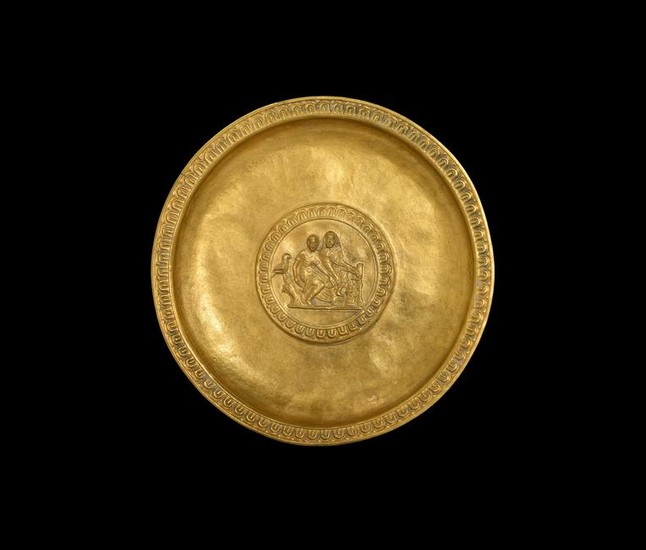Hellenistic or Thracian Gold Libation Dish
Late 2nd century BC. A shallow circular libation phiale for the ritual pouring of wine, featuring a flat rim decorated with a simple gadroon motif between two concentric ribs; this design repeated in the centre of the dish, enclosing a vignette of a seated couple offering a sacrifice to the gods in the form of a snake, which the male figure is casting into a burning altar; a bird perched on a tree stump to the proper right of the pair; the female figure holding a patera, at the feet of the male figure a bow and quiver (gorytos) containing arrows; the gadrooning worked in repoussé, the central vignette soldered in place; the disk of the plate with clear signs of hammering; the gadrooning repeated at the same two points on the underside of the dish. See Casson L., Venedikov I., Thracian Treasures from Bulgaria, New York, 1977; Oppermann M., Thraker, Griechen und Römer, an der Westküste des Schwarzen Meeres, Mainz am Rhein, 2007. The Thracians extracted gold and silver from the mountainous regions of the Rhodopes. This precious metal was then processed into finely crafted plates and vessels used for religious rituals and feasts, often featuring scenes from Thracian life and myth. Even by today's standards, the skill and artisanship of these craftsmen remains highly impressive. The Thracians used wine bowls in their rituals and feasts, a tradition which continued after the Macedonian and Roman conquests. Objects such as this one are frequently found deposited as burial goods in the graves of royalty and wealthy aristocrats of the period. In Thracian culture, wine was a sacred drink used in rituals which connected man with the divine, releasing the soul from the body as it was consumed; this is why the sacred drink was a pledge in the battle between gods and demons; those who imbibed it were believed to wield power over the past, present and future. Private collection, South West London; acquired before 2000; formerly in the Cohen family collection, said to have been in the family collection since the early 1900s; accompanied by an original sale receipt, dated 16 January 1986 and a positive metallurgical report written by Dr. Peter Northover (ex Department of Materials, Materials Science-Based Archaeology Group & Department of Materials, University of Oxford), number R5499, and an academic report by military specialist Dr Raffaele D'Amato. 253 grams, 18.3cm (7 1/4"). A video of this lot can be viewed on Timeline Auctions website.
Condition Report: Very fine condition.
View it on
Estimate
Time, Location
Auction House
Late 2nd century BC. A shallow circular libation phiale for the ritual pouring of wine, featuring a flat rim decorated with a simple gadroon motif between two concentric ribs; this design repeated in the centre of the dish, enclosing a vignette of a seated couple offering a sacrifice to the gods in the form of a snake, which the male figure is casting into a burning altar; a bird perched on a tree stump to the proper right of the pair; the female figure holding a patera, at the feet of the male figure a bow and quiver (gorytos) containing arrows; the gadrooning worked in repoussé, the central vignette soldered in place; the disk of the plate with clear signs of hammering; the gadrooning repeated at the same two points on the underside of the dish. See Casson L., Venedikov I., Thracian Treasures from Bulgaria, New York, 1977; Oppermann M., Thraker, Griechen und Römer, an der Westküste des Schwarzen Meeres, Mainz am Rhein, 2007. The Thracians extracted gold and silver from the mountainous regions of the Rhodopes. This precious metal was then processed into finely crafted plates and vessels used for religious rituals and feasts, often featuring scenes from Thracian life and myth. Even by today's standards, the skill and artisanship of these craftsmen remains highly impressive. The Thracians used wine bowls in their rituals and feasts, a tradition which continued after the Macedonian and Roman conquests. Objects such as this one are frequently found deposited as burial goods in the graves of royalty and wealthy aristocrats of the period. In Thracian culture, wine was a sacred drink used in rituals which connected man with the divine, releasing the soul from the body as it was consumed; this is why the sacred drink was a pledge in the battle between gods and demons; those who imbibed it were believed to wield power over the past, present and future. Private collection, South West London; acquired before 2000; formerly in the Cohen family collection, said to have been in the family collection since the early 1900s; accompanied by an original sale receipt, dated 16 January 1986 and a positive metallurgical report written by Dr. Peter Northover (ex Department of Materials, Materials Science-Based Archaeology Group & Department of Materials, University of Oxford), number R5499, and an academic report by military specialist Dr Raffaele D'Amato. 253 grams, 18.3cm (7 1/4"). A video of this lot can be viewed on Timeline Auctions website.
Condition Report: Very fine condition.



